Optical vortex coronagraph scatterometer
a scatterometer and optical vortex technology, applied in the field of optical vortex coronagraph scatterometer and method, can solve the problems of loss of signal in the glare of the illumination source, inability of typical devices to accurately determine scattering spectra at very low angles, and difficulty in distinguishing low-angle scattered light from more intense unscattered laser ligh
- Summary
- Abstract
- Description
- Claims
- Application Information
AI Technical Summary
Benefits of technology
Problems solved by technology
Method used
Image
Examples
example 1
[0026]This Example describes experimental results whereby a vortex coronagraph is used to measure the angular spectrum of scattered light, including at the zero angle. To measure the angular spectrum of scattered light an optical vortex coronagraph, as illustrated in FIG. 1 was used. A green HeNe laser (λ=543.5 nm) having a collimated beam radius (w=0.88 mm) was made normally incident to a thin scattering cell of inner path length Lc=0.50 mm. The cell contained a dilute water suspension of polystyrene spheres (certified mean diameter Ds=8.93 μm±0.07 μm, refractive index n≅1.597) at an approximate concentration of C=5×103 mm−3=0.16C0 where C0=4 / πDs2L=3.1×104 mm−3 is the scattering extinction parameter. A portion of the scattered light is transmitted through an aperture (AP) with diameter DAP=0.30 mm at a distance d=213 mm from the sample. According to the van Cittert-Zernike theorem, the coherence diameter of the extended scattering source, as measured at AP was Dcoh≈λd / w=0.13 mm. Th...
PUM
| Property | Measurement | Unit |
|---|---|---|
| beam divergence angle | aaaaa | aaaaa |
| beam divergence angle | aaaaa | aaaaa |
| focal lengths f1 | aaaaa | aaaaa |
Abstract
Description
Claims
Application Information
 Login to View More
Login to View More - R&D
- Intellectual Property
- Life Sciences
- Materials
- Tech Scout
- Unparalleled Data Quality
- Higher Quality Content
- 60% Fewer Hallucinations
Browse by: Latest US Patents, China's latest patents, Technical Efficacy Thesaurus, Application Domain, Technology Topic, Popular Technical Reports.
© 2025 PatSnap. All rights reserved.Legal|Privacy policy|Modern Slavery Act Transparency Statement|Sitemap|About US| Contact US: help@patsnap.com



